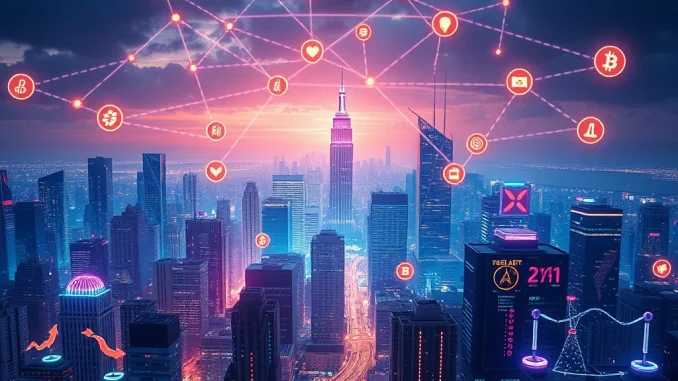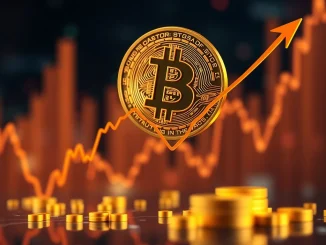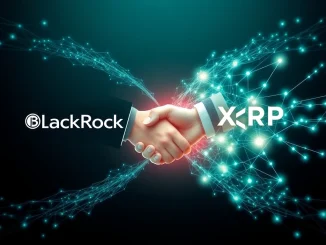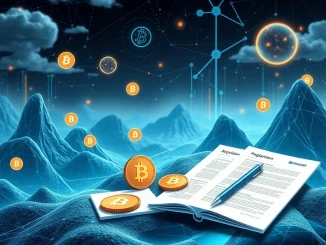
Get ready for a seismic shift in the financial landscape! Ripple (XRP), a major player in the crypto world, has dropped a bombshell report forecasting an astronomical growth in the tokenization market. Imagine a future where everything from your house to your favorite artwork is traded as easily as cryptocurrency. Ripple predicts this future is not just possible, but inevitable, projecting a staggering $18.9 trillion market cap by 2033. Are you prepared for this revolution?
What is Tokenization and Why is it a Game Changer?
Let’s break down this buzzword: tokenization. Simply put, it’s the process of representing real-world assets – think real estate, stocks, bonds, commodities, even art – as digital tokens on a blockchain. Ripple astutely describes it as the ‘next-generation alternative’ to our current, often slow and cumbersome financial systems. But why is this such a big deal?
Here’s why tokenization is poised to disrupt and reshape industries:
- Fractional Ownership: Ever dreamed of owning a piece of a Picasso or a prime piece of real estate but thought it was financially out of reach? Tokenization makes fractional ownership a reality. Instead of buying an entire asset, you can purchase fractions of it represented by tokens. This democratizes investment and opens up opportunities for more people.
- Increased Liquidity: Traditional assets like real estate can be notoriously illiquid. Selling a house can take months! Tokenized assets, on the other hand, can be traded much more easily and quickly on digital exchanges, boosting liquidity and efficiency.
- Enhanced Transparency and Security: Blockchain technology, the backbone of tokenization, provides unparalleled transparency and security. Every transaction is recorded on a distributed ledger, making it tamper-proof and easily auditable. This reduces fraud and increases trust.
- Reduced Costs and Complexity: Tokenization can streamline many processes involved in traditional asset management, reducing intermediaries and associated costs. Think about the paperwork and fees involved in buying and selling property – tokenization can significantly simplify these processes.
- 24/7 Global Markets: Crypto markets operate around the clock, and tokenized assets can leverage this infrastructure to create truly global and always-on marketplaces, breaking down geographical barriers and time zone limitations.
Ripple’s XRP and the Tokenization Revolution
Now, where does Ripple XRP fit into all of this? Ripple, known for its focus on enterprise blockchain solutions and its native cryptocurrency XRP, is deeply invested in the future of tokenization. While the report doesn’t explicitly state XRP’s direct role in the projected $18.9 trillion market, it’s clear that Ripple sees tokenization as a core part of the evolving financial ecosystem. Ripple’s technology is designed to facilitate faster, cheaper, and more transparent cross-border payments and asset movement – functionalities that are perfectly aligned with the needs of a burgeoning tokenized economy.
XRP, as a digital asset built for payments, could play a crucial role in the settlement and exchange of tokenized assets across different platforms and markets. Its speed and low transaction costs make it an attractive option for facilitating the movement of value in a tokenized world.
The Explosive Growth of Digital Assets: Why $18.9 Trillion?
An $18.9 trillion market by 2033 might sound like a number plucked from thin air, but Ripple’s forecast is grounded in the fundamental advantages that digital assets and tokenization offer. Several factors are driving this projected explosive growth:
- Increasing Institutional Adoption: Major financial institutions are waking up to the potential of tokenization. We’re seeing more and more banks, investment firms, and even governments exploring and adopting tokenized assets and blockchain technology. This institutional interest brings significant capital and credibility to the space.
- Technological Advancements: The underlying technology powering tokenization – blockchain – is constantly evolving and improving. Scalability solutions, interoperability protocols, and user-friendly platforms are making tokenization more accessible and practical.
- Demand for Alternative Investments: In a world of low interest rates and volatile traditional markets, investors are increasingly seeking alternative investment opportunities. Tokenized assets offer a diverse range of options, from real estate and commodities to collectibles and intellectual property, attracting a wider pool of investors.
- Regulatory Clarity (Slowly but Surely): While regulatory frameworks for digital assets are still evolving, there’s a growing trend towards greater clarity and acceptance from regulators worldwide. This increased regulatory certainty is crucial for fostering mainstream adoption and attracting institutional investment.
Navigating the Challenges of Blockchain Technology and Tokenization
While the future of blockchain technology and tokenization is bright, it’s important to acknowledge the challenges that need to be addressed for this vision to fully materialize:
| Challenge | Description |
|---|---|
| Regulatory Uncertainty | Lack of clear and consistent regulations across different jurisdictions remains a significant hurdle. Businesses and investors need clarity to operate confidently. |
| Scalability Issues | Some blockchain networks still face scalability challenges, limiting their ability to handle massive transaction volumes required for widespread tokenization. |
| Security Risks | While blockchain is inherently secure, vulnerabilities can exist in smart contracts and exchange platforms. Robust security measures are crucial to protect tokenized assets. |
| Interoperability | Lack of seamless interoperability between different blockchain platforms can create silos and hinder the efficient flow of tokenized assets. |
| Education and Awareness | Widespread adoption requires greater public understanding and awareness of tokenization and its benefits. Education initiatives are essential to bridge the knowledge gap. |
Examples of Tokenized Assets: Beyond the Hype
Tokenization isn’t just a futuristic concept; it’s already happening in various sectors. Here are some compelling examples of tokenized assets in action:
- Real Estate: Companies are tokenizing real estate properties, allowing investors to buy fractions of buildings and earn rental income proportionally. This opens up real estate investment to a much wider audience.
- Stocks and Equities: Tokenized stocks offer 24/7 trading, faster settlement, and fractional ownership, potentially revolutionizing stock markets.
- Art and Collectibles: High-value art and collectibles are being tokenized, making them more accessible for investment and trade, while also addressing issues of provenance and authenticity.
- Commodities: Tokenizing commodities like gold or oil can streamline supply chains, reduce costs, and increase transparency in trading.
- Carbon Credits: Tokenization can enhance the efficiency and transparency of carbon credit markets, facilitating environmental sustainability efforts.
Actionable Insights: Preparing for the Tokenized Future
So, how can you prepare for this impending crypto forecast and the rise of tokenization?
- Educate Yourself: Dive deeper into understanding tokenization, blockchain technology, and digital assets. Read reports, follow industry news, and explore online resources.
- Explore Investment Opportunities (Cautiously): As the tokenization market grows, explore potential investment opportunities in tokenized assets. However, always do your own research and understand the risks involved.
- Stay Informed About Regulatory Developments: Keep an eye on regulatory changes in the digital asset space. Regulatory clarity will significantly impact the growth and adoption of tokenization.
- Consider the Technology: If you are a business owner, explore how tokenization could benefit your operations. Could you tokenize assets to improve efficiency, access new markets, or enhance liquidity?
Conclusion: A Trillion-Dollar Transformation is on the Horizon
Ripple’s prediction of an $18.9 trillion tokenization market by 2033 might seem audacious, but it underscores the transformative potential of this technology. Tokenization is not just about creating digital representations of assets; it’s about fundamentally changing how we interact with and exchange value. By democratizing access, increasing efficiency, and enhancing transparency, tokenization is poised to unlock unprecedented opportunities and reshape the global financial landscape. As we move closer to this tokenized future, staying informed and prepared is key to capitalizing on this revolutionary shift.



